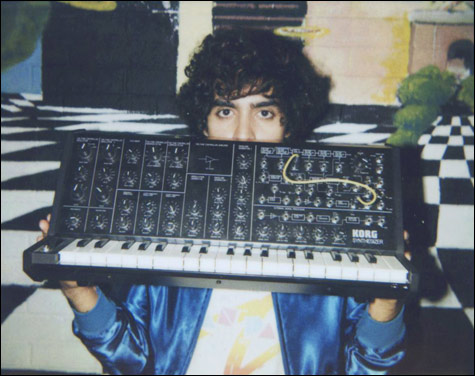The radiant, repressed pop of Neon Indian
By MICHAEL BRODEUR | March 5, 2010

BRAND NEW, YOU'RE RETRO Rather than aping the limitations of a bygone sound, Alan Palomo uses the gentle degeneration of our memory as a kind of musical model. |
Everybody please stop calling Alan Palomo "nostalgic." When I check in with him last Friday, the dude seems far more interested in whatever is on the horizon than whatever's in the past. He's hailing a cab to Prospect Heights, where he and Grizzly Bear's Chris Taylor will be preening the final frays of a new single, "Sleep Paralysist," in the latter's "church dungeon" studio space. I tell him I feel bad that he's been saddled with the burdens of ambassadorship for the fledgling fake genre of "chillwave" — the tenets of which his band, Neon Indian, seem to define."Here are my sentiments toward chillwave — and it's funny that I even have sentiments toward chillwave, because that is just an insane sentence." He pauses to give the cabbie the address. "I keep coming back to this idea: before, you had musical movements that were dictated by friends with similar objectives, confined to a city or a venue or a time. Now, instead, you have a blogger that can throw three or four bands together with very vague commonalities. It's assaulting in a way — you have to be the first to coin it so you can be the first to hate it."
Okay, I realize I asked you to stop thinking of him as nostalgic just before he began lamenting the current state of things, but hear him out. Sure, Palomo's most recent stretch of gently warped electronic pop as Neon Indian is decidedly chiller than his past efforts in Ghosthustler and as Vega. And the "-wave" suffix on the name that's been given to his music refers to the increasing number of bedroom-pop artistes with conspicuous lo-fi preferences, like South Carolina's Toro y Moi and Georgia's Washed Out. But though all three top-tier chillwave acts are often dismissed as a new stripe of retro — a kind of disingenuous faux fi amalgam of AM radio textures and languid melodic sensibilities — Palomo's work stands out as an exceptional exception. Rather than aping the limitations of a bygone sound ("How did the electro revival go from the most energizing sound to the most played-out thing ever?" he wonders), he uses the gentle degeneration of our memory as a kind of musical model. If I were a blogger, I'd call it "forgetro."
"You can revisit a sensation so many times through a memory that you warp it," he tells me in traffic. "You amplify certain things, soften others — a year goes by and you're left with a completely different memory. I try to interpret that with sonic elements, yes, but is it a conscious way for me to make you think of the theme to Chariots of Fire? No. Of course, some artists have a way of evoking a memory you've never had — I get that whenever I listen to 'Benny and the Jets.' "
 Topics
Topics:
Music Features
, Entertainment, Internet, Arts, Entertainment, and Media, More  , Entertainment, Internet, Arts, Entertainment, and Media, nostalgia, chillwave, Alan Palomo, Alan Palomo, Science and Technology, Technology, Music, Less
, Entertainment, Internet, Arts, Entertainment, and Media, nostalgia, chillwave, Alan Palomo, Alan Palomo, Science and Technology, Technology, Music, Less 